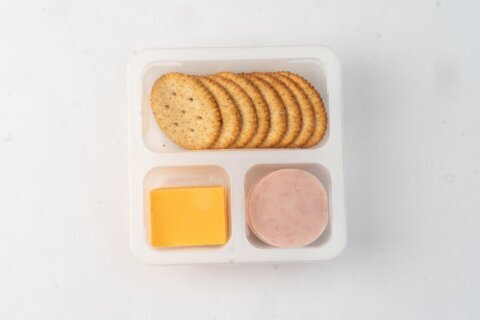WASHINGTON — Pizza is the world’s most popular food for a reason: It’s delicious. And that’s not an opinion; it’s science.
According to the American Chemical Society (ACS), pizza’s pleasing taste comes from special properties in its basic ingredients and a major chemical reaction that takes place when the pie is baked. It doesn’t matter whether you’re eating New York-, New Haven- or Chicago-style pizza; the end result is pure pleasure.
Matt Hartings, assistant professor of chemistry at American University, says the key to a tasty pizza starts with the dough. Pizza dough is a basic mix of flour, salt, yeast and warm water. When all of the ingredients are mixed together, the yeast reacts with the warm water and starts breaking down complex sugars in the flour, giving off carbon dioxide. This reaction makes the dough rise.
If you want the best-tasting dough, Hartings says to let the dough rise longer than normal.
“When you let the yeast work a little bit longer, the yeast actually starts making mistakes,” Hartings says. “Yeast is supposed to make carbon dioxide, and actually, they make ethanol with that carbon dioxide. But when you let them work longer than they should, they start making mistakes and those mistakes are flavor molecules. The longer rise time helps a lot with flavor development.”
Yes, pizza fans, a little bit of patience goes a long way.
Next up: the tomato sauce. Hartings says the tomato sauce adds a “bright” flavor to a pizza. That brightness is the acidity found in tomatoes. The ACS explains that this acidity is why some people experience acid reflux after eating pizza. If that happens to you, add a tiny pinch of baking soda to your tomato sauce. This will help neutralize the acid in the tomatoes.
It’s all in the layering of the dough and the sauce, too. Hartings says the contrast between the crispiness of the dough and the dampness of the tomato sauce is irresistible.
Many pizza fans consider the cheese the best part. And the way the cheese is made has a lot to do with the way in which it melts on a pizza.
Hartings says that most protein-based foods change texture when they are cooked. For example, when you fry an egg, the yolk goes from liquid to solid.
“But when you cook milk, it stays as a liquid, and to cook milk to make it turn into a solid, you have to add an acid,” says Hartings.
To make cheese, an ingredient such as lactic acid, lemon juice or vinegar is typically added to milk to help the proteins start clumping together. “And once they start clumping together, there are all sorts of fun things you can do to change their properties.”
Mozzarella is the most commonly used cheese for pizza; lots of calcium is added to it in the cheese-making process.
“And that calcium ensures that the cheese gets nice and ooey, gooey, stretchy,” Hartings says.
But the real magic happens when the pizza is cooked. In the oven, a chemical reaction takes place — one the the ACS calls “the holy grail of chemical reactions.”
“The Maillard reaction is something that no one has ever heard before, but it occurs in almost every food that we eat. Sometimes, it’s how we define savoriness or deliciousness. So anything that tastes savory has likely undergone the Maillard reaction,” Hartings says.
“The sugar and the protein are going to react together to make all sorts of flavor compounds … The proteins in the pizza dough and the sugars in the pizza dough react and your pizza dough browns; the sugars and the proteins in your cheese start to react together and they brown also. It’s a very generic sort of chemical reaction that happens everywhere, but it makes the most amazing flavors and aromas.”
Hartings says he is a big fan of pizza and is even an avid pizza maker. And his biggest secret to the perfect pizza — another science-based tip — is to cook the pizza on a baking steel.
“It’s about 3/8 of an inch of steel, and that steel soaks up so much energy that when you bake a pizza on it, you can bake a pizza so fast; it’s like being at any really fancy pizza restaurant,” says Hartings, who says he can cook a pizza in about three minutes using the steel.
“I like pizza any way you make it, but I do take pride in my pizza-making ability.”







